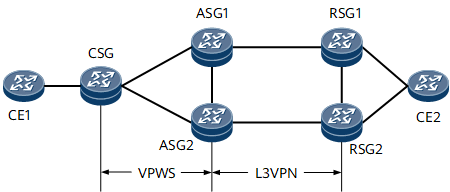Classification of L2VPN Accessing L3VPN
VPWS Accessing an L3VPN or Public Network
Virtual Private Wire Service (VPWS) provides MPLS network-based L2VPN services and transparently transmits Layer 2 data of users over an MPLS network. From the perspective of users, the MPLS access network is a Layer 2 switching network that provides Layer 2 connections between users and the carrier network. Users can access a public network or L3VPN services on the carrier network over VPWS connections.
On the network shown in Figure 1, L2VPN accessing L3VPN is deployed for CE1 and CE2 to communicate. The CSG is dual-homed to two ASGs, and the ASGs connect to the RSG over the L3VPN. PW APS-protected VPWS is deployed on the CSG, ASG1, and ASG2, and VE groups are created on ASGs to terminate VPWS and provide L3VPN access. VPN FRR is deployed on the L3VPN side to enhance service connection reliability.

PW APS is supported only on the NetEngine 8000 F1A.
VPLS Accessing a Public Network or L3VPN
VPLS connects multiple Ethernet LAN segments over a packet switched network (PSN). These Ethernet LAN segments function like a LAN.
Unlike point-to-point services of L2VPNs, VPLS can connect multiple Ethernet sites of a user to a public network or an L3VPN of the carrier's bearer network over an MPLS access network.
L2VPN Accessing Multiple L3VPNs Through L3VE QinQ VLAN Tag Termination Sub-interfaces
802.1Q-in-802.1Q (QinQ) is a Layer 2 tunnel protocol based on IEEE 802.1Q. Packets transmitted by means of QinQ carry double 802.1Q tags. QinQ distinguishes different types of services for different users.
Ethernet packets carried over VPWS or VPLS can carry either one or two tags. Currently, the NetEngine 8000 F can transmit service packets to different L2VPNs by adding different outer VLAN tags to these packets. When the packets with double VLAN tags reach an L3VE interface through an L2VPN, the L3VE sub-interfaces terminate QinQ packets with specified inner tags and transmit services of different types to their destination L3VPNs on the bearer network.
This allows the carrier to provide differentiated QoS guarantee for different services on the bearer network, helping the carrier to fully utilize network resources and provide Differentiated Services (DiffServ) for users.
